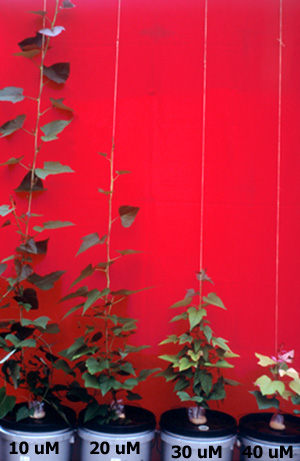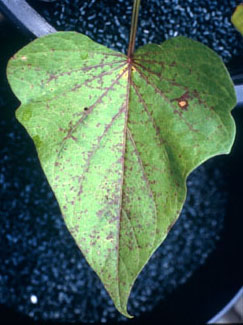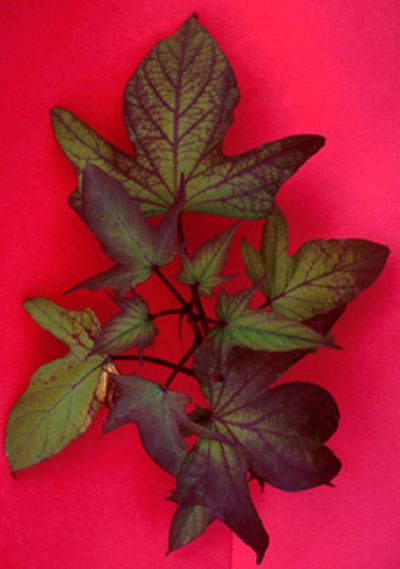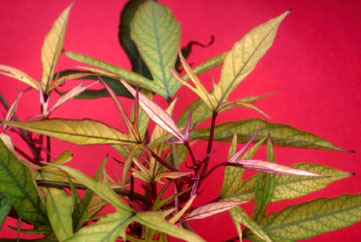|
Incidence of zinc (Zn) toxicity is rare and has not been reported in sweetpotato crops.
Cases in other crops have been reported on acid soils high in zinc, or on soils
overfertilised with zinc fertiliser. Zinc is also contained in some fungicides,
and may accumulate if these are used persistently.
Zinc toxicity may cause severe growth
reduction or prevent the establishment of transplanted cuttings. In solution
culture experiments, concentrations higher than 10 µM Zn in the root medium
decreased sweetpotato growth. At 50 µM Zn, growth was completely
stopped and death of roots was evident.
Specific visible symptoms are not always evident. Symptoms include the
development of dark pigmented spots or blotches on older leaves, or in more
severe cases, red pigmentation throughout the vine, particularly on petioles
and around margins and veins of the leaf blades. However, red pigmentation
is not observed in all cultivars. Severe damage to the roots at high zinc
concentration may cause general yellowing and wilting.
High levels of zinc inhibit the uptake of
iron, and it is common to find symptoms of severe iron deficiency induced by
zinc toxicity. Iron deficiency is characterised by a pale yellow to white
interveinal chlorosis on the younger leaves, and may eventually lead to
necrosis of the leaf blades and growing point. Cultivars which normally have
purple pigmentation in the youngest leaves become bright pink at the tip.
Symptoms of zinc-induced iron deficiency
may not be easily distinguished from those caused by an inadequate supply of
iron, unless other symptoms such as increased red pigmentation are expressed.
Zinc toxicity may be revealed by chemical analysis of the leaf tissue.
Concentrations of more than 70-85 mg
Zn/kg in the 7th to 9th youngest leaf blades were associated with reduced growth
due to zinc toxicity in solution culture experiments. Concentrations above 150
mg Zn/kg corresponded to severe stunting, whiles concentrations as high as 900 mg
Zn/kg were measured in severely affected plants.
In soil, a DTPA-extractable Zn
concentration above 10 mg/kg is considered potentially harmful in acid soils.
‘Total Zn’ concentrations in soil (perchloric acid extractable Zn) usually
fall in the range 10 to 300 mg/kg, with concentrations above 150 mg/kg regarded
as high (Landon, 1991), and likely to result in reduced plant growth.
Cultural control
Should zinc toxicity be found to occur in field-grown
sweetpotato, liming to raise the pH of the soil may alleviate the problem by
reducing the concentrations of plant-available zinc. Large applications of
phosphorus fertilisers may also have a beneficial effect.
Landon, R.J. 1991) (ed.) Booker tropical soil manual: a handbook for soil
survey and agricultural land evaluation in the tropics and subtropics. Booker
Tate Ltd; Longman, London.
O’Sullivan, J.N., Asher, C.J. and Blamey, F.P.C. 1997. Nutrient Disorders of Sweet Potato.
ACIAR Monograph No. 48, Australian Centre for International Agricultural
Research, Canberra, 136 p.
Contributed
by:
Jane O'Sullivan
|
Characteristics
and occurrence
Symptoms
Confusion
with other symptoms
Diagnostic
tests
Management
References

Reduced growth at higher levels of Zn.
Yellowing of leaves is due to induced Fe deficiency (J. O'Sullivan).


Dark red-brown pigmentation develops in some varieties, especially near veins on
older leaves (J.
O'Sullivan).

Symptoms of iron deficiency are commonly induced due to root
damage preventing iron uptake (J. O'Sullivan). |

